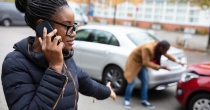How to make sure that the car you're buying is not stolen?
By: Aya Alhakim on June 13, 2024
Whether you’re buying a used car online or from a legitimate dealership, there’s a risk of it being stolen.
According to the Insurance Bureau of Canada (IBC), over 105,000 automobiles were stolen in Canada in 2022. That amounts to one car being taken every five minutes.
For the second year running, the expenses associated with vehicle theft claims have gone above $1 billion. Canada’s private auto insurers paid out $1.5 billion in theft claims in 2023. To put this in context, the average yearly cost of vehicle theft claims between 2018 and 2021 was $556 million.
So, with auto theft cases on the rise and with no signs of stopping, even buyers are being asked to be extra careful.
Read more: How expensive is it to insure one of Canada's top 10 most stolen vehicles?
In many cases, police say the dealership can be unaware that the car has been stolen until the new owner tries to register the vehicle. That’s typically the stage where the owner can discover that the Vehicle Identification Number (VIN) on their new car is fake.
However, if the authorities later determine that the car is stolen, they will seize it and return it to the rightful owner.
This means you’ll lose both the car and the money you have spent on it.
To avoid being put in that situation, here’s how you can protect yourself.
In this article:
Inspect the Vehicle Identification Number (VIN)
Every car has a VIN, which is made up of 17 numbers and letters used to uniquely identify any car, SUV, motorcycle, or truck. The number unlocks rich data about the car’s make and model, history, and more. In addition to helping insurers set premiums for auto insurance, it also allows police to identify vehicles in cases of damage or theft.
You can find your VIN on the ownership permit, and on the pink liability card (proof of insurance), as well as the vehicle itself.
The VIN provides seven key pieces of information about the specific car you are buying:
- Country code (first character): If the VIN starts with a 2, it means the vehicle was made in Canada. If it begins with a 1, 4, or 5, it means the car was made in the U.S.
- Manufacturer code (second and third characters): Each vehicle maker will have their own manufacturer code.
- Vehicle details (fourth through eighth characters): These characters provide descriptions of the vehicle, such as body and engine type.
- Authentication (ninth character): The ninth character, which can be either a number or the letter X, is used to verify that the VIN is genuine.
- Model year (tenth character)
- Serial number (final six characters): This unique combination sets it apart from all other cars of the same type and model year that were produced at the same factory.
The VIN helps ensure processes like registering, renewing license plates, or transferring ownership are hassle-free. It also helps auto shops order the right parts by identifying the car’s model and engine.
In case you get into an accident, accurate VINs help insurance companies rate policies correctly and verify ownership during claims.
Learn more: Forty per cent of drivers don’t know if they’re driving a high-risk vehicle - Survey
Check the original Vehicle Registration form, not a photocopy
Once you’ve found the car you want to buy, ask for the original computer-generated Vehicle Registration form, which is mandatory to transfer the ownership of a car.
You should also obtain proof of ownership and identification from the seller. With this documentation:
- Verify that the name on the car’s registration document matches the one on the photo identification provided by the seller.
- Make note of the seller’s contact details, such as home address, and driver’s license number.
- Confirm that the car's make, model and color match what is stated on the Vehicle Registration form.
- Obtain a pre-purchase inspection and a vehicle history report from companies like CARFAX. This will help you avoid buying a car that might be a clone, meaning it has a duplicate VIN number from a legitimate vehicle.
- If you’re in Ontario, get a Used Vehicle Information Package, which is a legally required document that gives buyers a description of a vehicle and its history.
How to use the VIN to avoid buying a stolen car
- Every car has its VIN displayed in two discreet places. The first one is located under the windshield and the other on the driver's door jamb. First, check to see if the VINs match.
- Make sure the VIN plates are not broken or missing. A few things to watch out for are mismatched or loose rivets, scratches on the numbers, and paint or glue covering the VIN.
- Enter the VIN on a free decoder tool to make sure it matches the car you’re buying.
Low sale prices should be a red flag
Beware of deals that appear too good to be true—they often are, so ask why.
Another red flag? If the seller asks for money to be paid in cash, which you should avoid at all costs. Unlike credit card payments or other traceable methods, cash transactions lack a paper trail, making it harder to dispute issues later.
It's recommended that you go with the seller to a legitimate bank and order a bank draft there.
Check the odometer on the car
Because cars with lower mileage tend to fetch higher prices at resale, shady sellers may try to roll back the odometer by tens of thousands of kilometers to try to dupe buyers into believing that the car is worth more than it actually is. This is an illegal practice known as odometer fraud. To spot signs of odometer fraud:
- Make sure that the odometer is marked and that the numbers are positioned correctly.
- Confirm that the mileage on the car corresponds with the car’s overall condition. The brake pedal, carpets, seats, steering wheel, and seat belts are high wear areas that require close inspection.
- Check that the oil change labels correspond with the odometer reading.
Remember: An average car travels 25,000 km per year.
What happens if I unknowingly purchase a stolen car?
In recent years, there has been a rise of what's called VIN cloning, which is the fraudulent practice of using a legally registered car's VIN to hide the identity of a stolen vehicle.
Thieves have become increasingly skilled at this by using advanced technology to alter VINs, making it nearly impossible for the average buyer to detect a cloned VIN.
CARFAX reported that Canada has seen a 63% increase in VIN cloning investigations from 2019 to 2023--an issue that could have unwitting buyers face lower resale value, expensive repairs and even legal problems.
What you need to keep in mind though is that it's not illegal if you unknowingly buy or possess stolen property, but ignoring suspicious situations or claiming ignorance won’t protect you.
However, if you do unknowingly buy a stolen car with a fake VIN, and police find out, you might end up facing fraud charges and have your car confiscated with no compensation. In most cases, insurance companies will also refuse to cover stolen or re-vinned cars.
While no single indicator can pinpoint a criminal seller, the more red flags there are, the more careful you should be as a buyer. Make sure all the paperwork matches up and don’t be afraid to walk away when you spot inconsistent details or sellers who avoid providing documentation.
Being cautious and aware of warnings signs can help you avoid the risk of ending up with a stolen vehicle.
Read next: What you need to know about insurance for a new versus used car
Save 20% on average on car insurance
Compare quotes from 50+ Canadian providers in 3 minutes.


